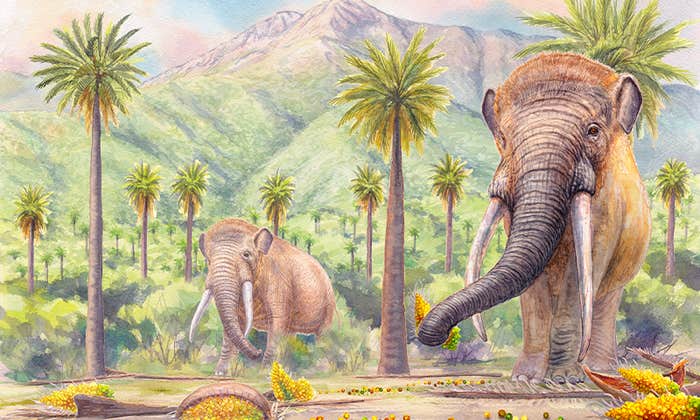A stocky male figure walks along a beach in what is now Gibraltar, on the southwestern tip of Europe, his pronounced brow shading his eyes. Pigeons watch over him on the cliffs overlooking the plain. Ducks float in the ocean off in the distance, and crows weave in and out of smoke from fires in the Rock of Gibraltar’s caves, and a trio of vultures surrounds a decaying ibex carcass. He turns from the birds to head home: Soon, he will depart on a 100-mile trek to hunt in the mountains.
That’s a likely story for at least one Neanderthal, whose fossilized remains archaeologists have recently found in a cave within the Rock of Gibraltar, last month granted World Heritage status. There’s a growing trend to use bird remains found in Neanderthal digs to help reconstruct the Neanderthal’s life: the things they wore, the trips they went on, and the ecology of the places they lived. The same cadre of birds like pigeons, ducks, and crows were still around back then, and now they might be trying to tell us the secrets of our hominid ancestors, says Clive Finlayson, director at the Gibraltar Museum. “When I started looking at the birds in these caves, my eyes opened when I saw these windows into the past.”
That’s because, while the climates have changed, birdie preferences haven’t. If scientists find a pigeon fossil in a Neanderthal site, they can safely assume the surrounding habitat must have been one that pigeons liked. Finlayson started his analysis by making a list of the 333 species of bird fossils found near Neanderthal sites across Europe, most of which still exist today. He put each fossil into a habitat bucket: Rock doves (your friendly neighborhood pigeons) prefer cliffs and ducks prefer wetlands, for example.
After reading the bird data, the team hypothesized that Neanderthals traveled between two specific sites: Gibraltar and another Neanderthal site called Zaffaraya, also in Spain, 100 miles away, and blocked from the coast by mountains. Zaffaraya’s bird fossil selection was similar to one specific part of Gibraltar, Ibex Cave, having pigeons and golden eagles. The similarities in birds between the caves, Finlayson says, imply that the area surrounding Zaffaraya might have looked a lot like Ibex cave, and that the Neanderthals could have been using the sites for a similar purpose. They probably spent most of their time in Gibraltar, and took winter treks to Zaffaraya for hunts, for instance.
“It’s not implausible,” says William Harcourt-Smith, who studies hominin fossils in East Africa for Lehman College and the American Museum of Natural History in New York. He was part of the team that analyzed the fossils of another hominin species, Homo naledi, last year. Those were found deep in a South African cave, with few other clues to help determine Homo naledi’s behavior. “These papers made me want to look at birds more,” says Harcourt-Smith. “We have another site with Ardipithecus (an early hominine), that has beautiful bird remains.”
“There’s a twist in the tale here.”
Others aren’t convinced that these birds provide much insight into the Neanderthal’s Paleolithic environment. Jon Mitchell, a University of Chicago paleontologist who studies the ecology of ancient birds, felt Finlayson’s team relied too heavily on birds like ducks and pigeons. Pigeons were common even in the Paleolithic era, and duck fossils preserve especially well, he says, so both end up in archaeological sites everywhere like they end up in cities everywhere. Since birds can, you know, fly, says Mitchell, the bird fossils in an archaeological site might not be enough to tell whether the bird’s habitat was nearby. “I’ve been doing fieldwork in Utah and seen ducks piddling around on the cow pond but that doesn’t mean that’s a wetland environment,” he says.
But aside from the environment, the bird themselves might provide even more data to other Neanderthal hypotheses. Would you eat a crow, generally a bad-tasting bird? No? The Neanderthals might not have, either, but were still killing them. Ivana Fiore and a team of Italian archaeologists, for example, published a report in May analyzing 680 bird fossils at Fumane Cave on a plateau in rugged northern Italy. They looked at the marks the Neanderthals left on each bone, both macro and microscopic. While there were teeth marks, implying the bones could have been left over from a feast, other markings were apparently left by tools on places without much meat, like the glossy, black-feathered wings of small crows.
As it happens, this lends further credence to the idea that they were collecting feathers for decoration or clothing rather than discarding them, well before humans migrated to Europe. “Either modern humans developed this behavior independently, or maybe they learned it from the Neanderthals,” says Finlayson. “There’s a twist in the tale here.” To Veronique Laroulandie, an archaeologist at the Université de Bordeaux, in France, Finlayson might be stretching it. “Whether Neanderthal and modern humans have met is still being discussed,” she says, “even if some DNA analyses show a mixture somewhere in the ancient world.” But she did find his idea intriguing. “It’s a reverse of the paradigm that was dominant for many years.”
Ryan Mandelbaum is serious about science, pizza, Guy Fieri and not much else. His work has appeared in places like Popular Science, Astronomy Magazine Online, and the Washington Post. He pulls over to look at birds and calls neutrinos “little dudes.”
The lead photograph is courtesy of hjjanisch via Flickr.




























